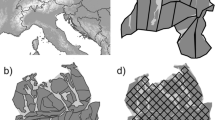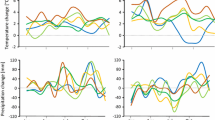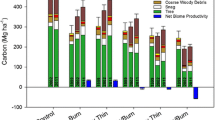Abstract
Forests are a significant part of the global carbon cycle and are increasingly viewed as tools for mitigating climate change. Natural disturbances, such as fire, can reduce carbon storage. However, many forests and dependent species evolved with frequent fire as an integral ecosystem process. We used a landscape forest simulation model to evaluate the effects of endangered species habitat management on carbon sequestration. We compared unmanaged forests (control) to forests managed with prescribed burning and prescribed burning combined with thinning. Management treatments followed guidelines of the recovery plan for the endangered red-cockaded woodpecker (RCW), which requires low-density longleaf pine (Pinus palustris) forest. The unmanaged treatment provided the greatest carbon storage, but at the cost of lost RCW habitat. Thinning and burning treatments expanded RCW habitat by increasing the dominance of longleaf pine and reducing forest density, but stored 22% less total ecosystem carbon compared to the control. Our results demonstrate that continued carbon sequestration and the provision of RCW habitat are not incompatible goals, although there is a tradeoff between habitat extent and total ecosystem carbon across the landscape. Management for RCW habitat might also increase ecosystem resilience, as longleaf pine is tolerant of fire and drought, and resistant to pests. Restoring fire-adapted forests requires a reduction in carbon. However, the size of the reduction, the effects on sequestration rates, and the co-benefits from other ecosystem services should be evaluated in the context of the specific forest community targeted for restoration.







Similar content being viewed by others
References
Birdsey RA. 1992. Carbon storage and accumulation in United States forest ecosystems. Washington, DC: US Department of Agriculture, Forest Service.
Bonan GB. 2008. Forests and climate change: forcings, feedbacks, and the climate benefits of forests. Science 320:1444–9.
Brown JK. 1974. Handbook for inventorying downed woody material. General Technical Report INT-16. Ogden, UT: US Department of Agriculture, Forest Service, Intermountain Forest and Range Experiment Station.
Canadell JG, Le Quéré C, Raupach MR, Field CB, Buitenhuis ET, Ciais P, Conway TJ, Gillett NP, Houghton RA, Marland G. 2007. Contributions to accelerating atmospheric CO2 growth from economic activity, carbon intensity, and efficiency of natural sinks. Proc Natl Acad Sci USA 104:18866–70.
Canadell JG, Raupach MR. 2008. Managing forests for climate change mitigation. Science 320:1456–7.
Caspersen JP, Pacala SW, Jenkins JC, Hurtt GC, Moorcroft PR, Birdsey RA. 2000. Contributions of land-use history to carbon accumulation in U.S. Forests. Science 290:1148–51.
Chapin FS, Matson PPA. 2011. Principles of terrestrial ecosystem ecology. New York: Springer.
Dangal SRS, Felzer BS, Hurteau MD. 2014. Effects of agriculture and timber harvest on carbon sequestration in the eastern US forests. J Geophys Res. doi:10.1002/2013JG002409.
Dilustro JJ, Collins BS, Duncan LK, Sharitz RR. 2002. Soil texture, land-use intensity, and vegetation of Fort Benning upland forest sites. J Torrey Bot Soc 129:289–97.
Earles M, North M, Hurteau M. 2014. Wildfire and drought dynamics destabilize carbon stores of fire-suppressed forests. Ecol Appl 24:732–40.
Engstrom RT, Sanders FJ. 1997. Red-cockaded Woodpecker foraging ecology in an old-growth longleaf pine forest. Wilson Bull 109:203–17.
Ford CR, McGee J, Scandellari F, Hobbie EA, Mitchell RJ. 2012. Long- and short-term precipitation effects on soil CO2 efflux and total belowground carbon allocation. Agric For Meteorol 156:54–64.
Gilliam FS, Platt WJ. 1999. Effects of long-term fire exclusion on tree species composition and stand structure in an old-growth Pinus palustris (Longleaf pine) forest. Plant Ecol 140:15–26.
Glitzenstein JS, Platt WJ, Streng DR. 1995. Effects of fire regime and habitat on tree dynamics in north Florida longleaf pine savannas. Ecol Monogr 65:441–76.
Gustafson EJ, Shifley SR, Mladenoff DJ, Nimerfro KK, He HS. 2000. Spatial simulation of forest succession and timber harvesting using LANDIS. Can J For Res 30:32–43.
Hooker TD, Compton JE. 2003. Forest ecosystem carbon and nitrogen accumulation during the first century after agricultural abandonment. Ecol Appl 13:299–313.
Houghton RA. 2003. Revised estimates of the annual net flux of carbon to the atmosphere from changes in land use and land management 1850–2000. Tellus B 55:378–90.
Hurteau M, North M. 2009. Fuel treatment effects on tree-based forest carbon storage and emissions under modeled wildfire scenarios. Front Ecol Environ 7:409–14.
Hurteau MD, Brooks ML. 2011. Short- and long-term effects of fire on carbon in us dry temperate forest systems. Bioscience 61:139–46.
Hurteau MD, Hungate BA, Koch GW, North MP, Smith GR. 2013. Aligning ecology and markets in the forest carbon cycle. Front Ecol Environ 11:37–42.
Hurteau MD, Stoddard MT, Fule PZ. 2011. The carbon costs of mitigating high-severity wildfire in southwestern ponderosa pine. Glob Change Biol 17:1516–21.
Jenkins JC, Chojnacky DC, Heath LS, Birdsey RA. 2003. National-scale biomass estimators for United States tree species. For Sci 49:12–35.
Johnsen KH, Butnor JR, Kush JS, Schmidtling RC, Nelson CD. 2009. Hurricane Katrina winds damaged longleaf pine less than loblolly pine. South J Appl For 33:178–81.
Kirkman LK, Coffey KL, Mitchell RJ, Moser EB. 2004. Ground cover recovery patterns and life-history traits: implications for restoration obstacles and opportunities in a species-rich savanna. J Ecol 92:409–21.
Kirkman LK, Mitchell RJ, Helton RC, Drew MB. 2001. Productivity and species richness across an environmental gradient in a fire-dependent ecosystem. Am J Bot 88:2119–28.
Kush JS, Meldahl RS, McMahon CK, Boyer WD. 2004. Longleaf pine: a sustainable approach for increasing terrestrial carbon in the southern United States. Environ Manage 33:S139–47.
Landers JL, Vanlear DH, Boyer WD. 1995. The longleaf pine forests of the Southeast—requiem or renaissance. J For 93:39–44.
Lemon PC. 1949. Successional responses of herbs in the longleaf-slash pine forest after fire. Ecology 30:135–45.
Li DJ, Niu SL, Luo YQ. 2012. Global patterns of the dynamics of soil carbon and nitrogen stocks following afforestation: a meta-analysis. New Phytol 195:172–81.
Markewitz D, Sartori F, Craft C. 2002. Soil change and carbon storage in longleaf pine stands planted on marginal agricultural lands. Ecol Appl 12:1276–85.
Metherell AK, Harding LA, Cole CV, Parton WJ. 1993. CENTURY soil organic matter model environment technical documentation. Agroecosystem Version 4.0. Fort Collins, CO: USDA-ARS.
Mitchell R, Engstrom T, Sharitz RR, De Steven D, Hiers K, Cooper R, Kirkman LK. 2009. Old forests and endangered woodpeckers: old-growth in the southern coastal plain. Nat Areas J 29:301–10.
Mitchell RJ, Kirkman LK, Pecot SD, Wilson CA, Palik BJ, Boring LR. 1999. Patterns and controls of ecosystem function in longleaf pine-wiregrass savannas. I. Aboveground net primary productivity. Can J For Res 29:743–51.
Nowacki GJ, Abrams MD. 2008. The demise of fire and “Mesophication” of forests in the eastern United States. Bioscience 58:123–38.
NRCS. 2013. Web Soil Survey. United States Department of Agriculture Natural Resources Conservation Service. Available online at http://websoilsurvey.nrcs.usda.gov. Accessed 1 July 2013.
Onaindia M, Fernández de Manuel B, Madariaga I, Rodríguez-Loinaz G. 2013. Co-benefits and trade-offs between biodiversity, carbon storage and water flow regulation. For Ecol Manage 289:1–9.
Pacala S, Socolow R. 2004. Stabilization wedges: solving the climate problem for the next 50 years with current technologies. Science 305:968–72.
Pan Y, Chen JM, Birdsey R, McCullough K, He L, Deng F. 2011. Age structure and disturbance legacy of North American forests. Biogeosciences 8:715–32.
Parton WJ. 1996. The CENTURY model. In: Powlson D, Smith P, Smith J, Eds. Evaluation of soil organic matter models. Berlin: Springer. p 283–91.
Parton WJ, Scurlock JMO, Ojima DS, Gilmanov TG, Scholes RJ, Schimel DS, Kirchner T, Menaut JC, Seastedt T, Moya EG, Kamnalrut A, Kinyamario JI. 1993. Observations and modeling of biomass and soil organic matter dynamics for the grassland biome worldwide. Global Biogeochem Cycles 7:785–809.
Pastor J, Post WM. 1986. Influence of climate, soil-moisture, and succession on forest carbon and nitrogen cycles. Biogeochemistry 2:3–27.
Post WM, Emanuel WR, Zinke PJ, Stangenberger AG. 1982. Soil carbon pools and world life zones. Nature 298:156–9.
Pregitzer KS, Euskirchen ES. 2004. Carbon cycling and storage in world forests: biome patterns related to forest age. Glob Change Biol 10:2052–77.
Remucal JM, McGee JD, Fehrenbacher MM, Best C, Mitchell RJ. 2013. Application of the climate action reserve’s forest project protocol to a longleaf pine forest under restoration management. J For 111:59–66.
Restaino JC, Peterson DL. 2013. Wildfire and fuel treatment effects on forest carbon dynamics in the western United States. For Ecol Manage 303:46–60.
Richter DD, Markewitz D, Trumbore SE, Wells CG. 1999. Rapid accumulation and turnover of soil carbon in a re-establishing forest. Nature 400:56–8.
Samuelson LJ, Stokes TA, Butnor JR, Johnsen KH, Gonzalez-Benecke CA, Anderson P, Jackson J, Ferrari L, Martin TA, Cropper Jr WP. 2014. Ecosystem carbon stocks in Pinus palustris forests. Can J For Res (in press).
Samuelson LJ, Stokes TA, Johnsen KH. 2012. Ecophysiological comparison of 50-year-old longleaf pine, slash pine and loblolly pine. For Ecol Manage 274:108–15.
Samuelson LJ, Whitaker WB. 2012. Relationships between soil CO2 efflux and forest structure in 50-year-old longleaf pine. For Sci 58:472–84.
Scheller RM, Domingo JB, Sturtevant BR, Williams JS, Rudy A, Gustafson EJ, Mladenoff DJ. 2007. Design, development, and application of LANDIS-II, a spatial landscape simulation model with flexible temporal and spatial resolution. Ecol Model 201:409–19.
Scheller RM, Hua D, Bolstad PV, Birdsey RA, Mladenoff DJ. 2011a. The effects of forest harvest intensity in combination with wind disturbance on carbon dynamics in Lake States Mesic Forests. Ecol Model 222:144–53.
Scheller RM, Van Tuyl S, Clark KL, Hom J, La Puma I. 2011b. Carbon sequestration in the new jersey pine barrens under different scenarios of fire management. Ecosystems 14:987–1004.
Schiffman PM, Johnson WC. 1989. Phytomass and detrital carbon storage during forest regrowth in the southeastern United States Piedmont. Can J For Res 19:69–78.
Schimel DS, Braswell BH, Holland EA, McKeown R, Ojima DS, Painter TH, Parton WJ, Townsend AR. 1994. Climatic, edaphic, and biotic controls over storage and turnover of carbon in soils. Global Biogeochem Cycles 8:279–93.
Scott JH, Burgan RE. 2005. Standard fire behavior fuel models: a comprehensive set for use with Rothermel’s surface fire spread model. The Bark Beetles, Fuels, and Fire Bibliography: 66.
Smith P, Smith JU, Powlson DS, McGill WB, Arah JRM, Chertov OG, Coleman K, Franko U, Frolking S, Jenkinson DS, Jensen LS, Kelly RH, Klein-Gunnewiek H, Komarov AS, Li C, Molina JAE, Mueller T, Parton WJ, Thornley JHM, Whitmore AP. 1997. A comparison of the performance of nine soil organic matter models using datasets from seven long-term experiments. Geoderma 81:153–225.
Sturtevant BR, Scheller RM, Miranda BR, Shinneman D, Syphard A. 2009. Simulating dynamic and mixed-severity fire regimes: a process-based fire extension for LANDIS-II. Ecol Model 220:3380–93.
USFWS. 2003. Recovery plan for the red-cockaded woodpecker (Picoides borealis): second revision. Atlanta, GA: United States Fish and Wildlife Service. p 296.
Van Wagner CE, Stocks BJ, Lawson BD, Alexander ME, Lynham TJ, McAlpine RS. 1992. Development and structure of the Canadian forest fire behavior prediction system. Ottawa, ON: Fire Danger Group, Forestry Canada.
Varner JM, Gordon DR, Putz E, Hiers JK. 2005. Restoring fire to long-unburned Pinus palustris ecosystems: novel fire effects and consequences for long-unburned ecosystems. Restor Ecol 13:536–44.
Walker J, Peet RK. 1984. Composition and species-diversity of pine-wiregrass savannas of the Green Swamp, North Carolina. Vegetatio 55:163–79.
West DC, Doyle TW, Tharp ML, Beauchamp JJ, Platt WJ, Downing DJ. 1993. Recent growth increases in old-growth longleaf pine. Can J For Res 23:846–53.
Whelan A, Mitchell R, Staudhammer C, Starr G. 2013. Cyclic occurrence of fire and its role in carbon dynamics along an edaphic moisture gradient in longleaf pine ecosystems. PLoS One 8(1):e54045.
Wilson CA, Mitchell RJ, Hendricks JJ, Boring LR. 1999. Patterns and controls of ecosystem function in longleaf pine-wiregrass savannas. II. Nitrogen dynamics. Can J For Res 29:752–60.
Zhao SQ, Liu SG, Li ZP, Sohl TL. 2010. Federal land management, carbon sequestration, and climate change in the southeastern us: A case study with Fort Benning. Environ Sci Technol 44:992–7.
Acknowledgements
Funding for this research was provided by the US Department of Defense’s Strategic Environmental Research Development Program (SERDP). We thank the Ft. Benning field crew for assistance with data collection and James Parker and Rob Addington for providing data and facilitating access to field locations. We are grateful for the constructive feedback from anonymous reviewers.
Author information
Authors and Affiliations
Corresponding author
Additional information
Author Contributions
KLM performed research and analyzed the data; MDH, BAH, GWK, and MPN conceived of and designed the study; KLM, MDH, BAH, GWK, and MPN wrote the paper.
Electronic Supplementary Material
Below is the link to the electronic supplementary material.
Rights and permissions
About this article
Cite this article
Martin, K.L., Hurteau, M.D., Hungate, B.A. et al. Carbon Tradeoffs of Restoration and Provision of Endangered Species Habitat in a Fire-Maintained Forest. Ecosystems 18, 76–88 (2015). https://doi.org/10.1007/s10021-014-9813-1
Received:
Accepted:
Published:
Issue Date:
DOI: https://doi.org/10.1007/s10021-014-9813-1




